Characterizing Longitudinal Changes in the Impedance Spectra of In-Vivo Peripheral Nerve Electrodes
Abstract
:1. Introduction
2. Materials and Methods
2.1. Surgical Procedure
2.2. Impedance Measurements
2.3. Visualization of Spectra
2.4. Categorization Algorithm
- (1)
- (2)
- (3)
- (4)
- (1)
- (1)
- (2)
- (3)
2.5. Equivalence Circuit Model
2.6. Machine Learning Algorithm
2.7. Statistics
3. Results
3.1. Description of Classes
3.2. Longitudinal 1 kHz Impedances
3.3. Fitting Categories to Randles Model
3.4. Longitudinal Changes of Categories
4. Discussion
4.1. Physical Characteristics Underlying Groups
4.2. Categorization Algorithms
4.3. Future Work
5. Conclusions
Supplementary Materials
Author Contributions
Funding
Disclaimer
Conflicts of Interest
References
- Franks, W.; Schenker, I.; Schmutz, P.; Hierlemann, A. Impedance Characterization and Modeling of Electrodes for Biomedical Applications. IEEE Trans. Biomed. Eng. 2005, 52, 1295–1302. [Google Scholar] [CrossRef] [PubMed]
- Mercanzini, A.; Colin, P.; Bensadoun, J.-C.; Bertsch, A.; Renaud, P. In Vivo Electrical Impedance Spectroscopy of Tissue Reaction to Microelectrode Arrays. IEEE Trans. Biomed. Eng. 2009, 56, 1909–1918. [Google Scholar] [CrossRef] [PubMed]
- Prasad, A.; Xue, Q.-S.; Dieme, R.; Sankar, V.; Mayrand, R.C.; Nishida, T.; Streit, W.J.; Sanchez, J.C. Abiotic-Biotic Characterization of Pt/Ir Microelectrode Arrays in Chronic Implants. Front. Neuroeng. 2014, 7, 2. [Google Scholar] [CrossRef] [PubMed]
- Caldwell, R.; Sharma, R.; Takmakov, P.; Street, M.G.; Solzbacher, F.; Tathireddy, P.; Rieth, L. Neural Electrode Resilience against Dielectric Damage May Be Improved by Use of Highly Doped Silicon as a Conductive Material. J. Neurosci. Methods 2018, 293, 210–225. [Google Scholar] [CrossRef] [PubMed]
- Rousche, P.J.; Normann, R.A. Chronic Recording Capability of the Utah Intracortical Electrode Array in Cat Sensory Cortex. J. Neurosci. Methods 1998, 82, 1–15. [Google Scholar] [CrossRef]
- Jones, K.E.; Campbell, P.K.; Normann, R.A. A Glass/Silicon Composite Intracortical Electrode Array. Ann. Biomed. Eng. 1992, 20, 423–437. [Google Scholar] [CrossRef] [PubMed]
- Bhandari, R.; Negi, S.; Rieth, L.; Solzbacher, F. A Wafer-Scale Etching Technique for High Aspect Ratio Implantable MEMS Structures. Sens. Actuators A Phys. 2010, 162, 130–136. [Google Scholar] [CrossRef] [PubMed]
- Vasudevan, S.; Huang, J.; Botterman, B.; Matloub, H.S.; Keefer, E.; Cheng, J. Detergent-Free Decellularized Nerve Grafts for Long-Gap Peripheral Nerve Reconstruction. Plast. Reconstr. Surg. Glob. Open 2014, 2, e201. [Google Scholar] [CrossRef] [PubMed]
- Vasudevan, S.; Patel, K.; Welle, C. Rodent Model for Assessing the Long Term Safety and Performance of Peripheral Nerve Recording Electrodes. J. Neural Eng. 2017, 14, 016008. [Google Scholar] [CrossRef] [PubMed]
- Vasudevan, S.; Yan, J.-G.; Zhang, L.-L.; Matloub, H.S.; Cheng, J.J. A Rat Model for Long-Gap Peripheral Nerve Reconstruction. Plast. Reconstr. Surg. 2013, 132, 871–876. [Google Scholar] [CrossRef] [PubMed]
- Kane, S.R.; Cogan, S.F.; Ehrlich, J.; Plante, T.D.; McCreery, D.B. Electrical Performance of Penetrating Microelectrodes Chronically Implanted in Cat Cortex. In Proceedings of the 2011 Annual International Conference of the IEEE Engineering in Medicine and Biology Society, Boston, MA, USA, 30 August–3 September 2011; IEEE: Piscataway, NJ, USA, 2011; Volume 2011, pp. 5416–5419. [Google Scholar]
- Cogan, S.F.; Ehrlich, J.; Plante, T.D.; Smirnov, A.; Shire, D.B.; Gingerich, M.; Rizzo, J.F. Sputtered Iridium Oxide Films for Neural Stimulation Electrodes. J. Biomed. Mater. Res. Part B Appl. Biomater. 2009, 89B, 353–361. [Google Scholar] [CrossRef] [PubMed]
- Randles, J.E.B. Kinetics of Rapid Electrode Reactions. Discuss. Faraday Soc. 1947, 1, 11. [Google Scholar] [CrossRef]
- Leber, M.; Bhandari, R.; Mize, J.; Warren, D.J.; Shandhi, M.M.H.; Solzbacher, F.; Negi, S. Long Term Performance of Porous Platinum Coated Neural Electrodes. Biomed. Microdevices 2017, 19, 62. [Google Scholar] [CrossRef] [PubMed]
- Leber, M.; Shandhi, M.M.H.; Hogan, A.; Solzbacher, F.; Bhandari, R.; Negi, S. Different Methods to Alter Surface Morphology of High Aspect Ratio Structures. Appl. Surf. Sci. 2016, 365, 180–190. [Google Scholar] [CrossRef] [PubMed]
- Weiland, J.D.; Anderson, D.J. Chronic Neural Stimulation with Thin-Film, Iridium Oxide Electrodes. IEEE Trans. Biomed. Eng. 2000, 47, 911–918. [Google Scholar] [CrossRef] [PubMed]
- Prasad, A.; Sanchez, J.C. Quantifying Long-Term Microelectrode Array Functionality Using Chronic In Vivo Impedance Testing. J. Neural Eng. 2012, 9, 026028. [Google Scholar] [CrossRef] [PubMed]
- Newbold, C.; Richardson, R.; Millard, R.; Huang, C.; Milojevic, D.; Shepherd, R.; Cowan, R. Changes in Biphasic Electrode Impedance with Protein Adsorption and Cell Growth. J. Neural Eng. 2010, 7, 056011. [Google Scholar] [CrossRef] [PubMed]
- Takmakov, P.; Ruda, K.; Scott Phillips, K.; Isayeva, I.S.; Krauthamer, V.; Welle, C.G. Rapid Evaluation of the Durability of Cortical Neural Implants Using Accelerated Aging with Reactive Oxygen Species. J. Neural Eng. 2015, 12, 026003. [Google Scholar] [CrossRef] [PubMed]
- Cody, P.A.; Eles, J.R.; Lagenaur, C.F.; Kozai, T.D.Y.; Cui, X.T. Unique Electrophysiological and Impedance Signatures between Encapsulation Types: An Analysis of Biological Utah Array Failure and Benefit of a Biomimetic Coating in a Rat Model. Biomaterials 2018, 161, 117–128. [Google Scholar] [CrossRef] [PubMed]
- Simeral, J.D.; Kim, S.-P.; Black, M.J.; Donoghue, J.P.; Hochberg, L.R. Neural Control of Cursor Trajectory and Click by a Human with Tetraplegia 1000 Days after Implant of an Intracortical Microelectrode Array. J. Neural Eng. 2011, 8, 025027. [Google Scholar] [CrossRef] [PubMed]
- Barrese, J.C.; Rao, N.; Paroo, K.; Triebwasser, C.; Vargas-Irwin, C.; Franquemont, L.; Donoghue, J.P. Failure Mode Analysis of Silicon-Based Intracortical Microelectrode Arrays in Non-Human Primates. J. Neural Eng. 2013, 10, 066014. [Google Scholar] [CrossRef] [PubMed]
- Malaga, K.A.; Schroeder, K.E.; Patel, P.R.; Irwin, Z.T.; Thompson, D.E.; Nicole Bentley, J.; Lempka, S.F.; Chestek, C.A.; Patil, P.G. Data-Driven Model Comparing the Effects of Glial Scarring and Interface Interactions on Chronic Neural Recordings in Non-Human Primates. J. Neural Eng. 2016, 13, 016010. [Google Scholar] [CrossRef] [PubMed]
- Williams, J.C.; Hippensteel, J.A.; Dilgen, J.; Shain, W.; Kipke, D.R. Complex Impedance Spectroscopy for Monitoring Tissue Responses to Inserted Neural Implants. J. Neural Eng. 2007, 4, 410–423. [Google Scholar] [CrossRef] [PubMed]
- McConnell, G.C.; Rees, H.D.; Levey, A.I.; Gutekunst, C.-A.; Gross, R.E.; Bellamkonda, R.V. Implanted Neural Electrodes Cause Chronic, Local Inflammation That Is Correlated with Local Neurodegeneration. J. Neural Eng. 2009, 6, 056003. [Google Scholar] [CrossRef] [PubMed]
- Szarowski, D.H.; Andersen, M.D.; Retterer, S.; Spence, A.J.; Isaacson, M.; Craighead, H.G.; Turner, J.N.; Shain, W. Brain Responses to Micro-Machined Silicon Devices. Brain Res. 2003, 983, 23–35. [Google Scholar] [CrossRef]
- Polikov, V.S.; Tresco, P.A.; Reichert, W.M. Response of Brain Tissue to Chronically Implanted Neural Electrodes. J. Neurosci. Methods 2005, 148, 1–18. [Google Scholar] [CrossRef] [PubMed]
- Spataro, L.; Dilgen, J.; Retterer, S.; Spence, A.J.; Isaacson, M.; Turner, J.N.; Shain, W. Dexamethasone Treatment Reduces Astroglia Responses to Inserted Neuroprosthetic Devices in Rat Neocortex. Exp. Neurol. 2005, 194, 289–300. [Google Scholar] [CrossRef] [PubMed]
- Nolta, N.F.; Christensen, M.B.; Crane, P.D.; Skousen, J.L.; Tresco, P.A. BBB Leakage, Astrogliosis, and Tissue Loss Correlate with Silicon Microelectrode Array Recording Performance. Biomaterials 2015, 53, 753–762. [Google Scholar] [CrossRef] [PubMed]
- Jorfi, M.; Skousen, J.L.; Weder, C.; Capadona, J.R. Progress towards Biocompatible Intracortical Microelectrodes for Neural Interfacing Applications. J. Neural Eng. 2015, 12, 011001. [Google Scholar] [CrossRef] [PubMed]
- Kozai, T.D.Y.; Catt, K.; Li, X.; Gugel, Z.V.; Olafsson, V.T.; Vazquez, A.L.; Cui, X.T. Mechanical Failure Modes of Chronically Implanted Planar Silicon-Based Neural Probes for Laminar Recording. Biomaterials 2015, 37, 25–39. [Google Scholar] [CrossRef] [PubMed]
- Davis, E.M.; Benetatos, N.M.; Regnault, W.F.; Winey, K.I.; Elabd, Y.A. The Influence of Thermal History on Structure and Water Transport in Parylene C Coatings. Polymer 2011, 52, 5378–5386. [Google Scholar] [CrossRef]
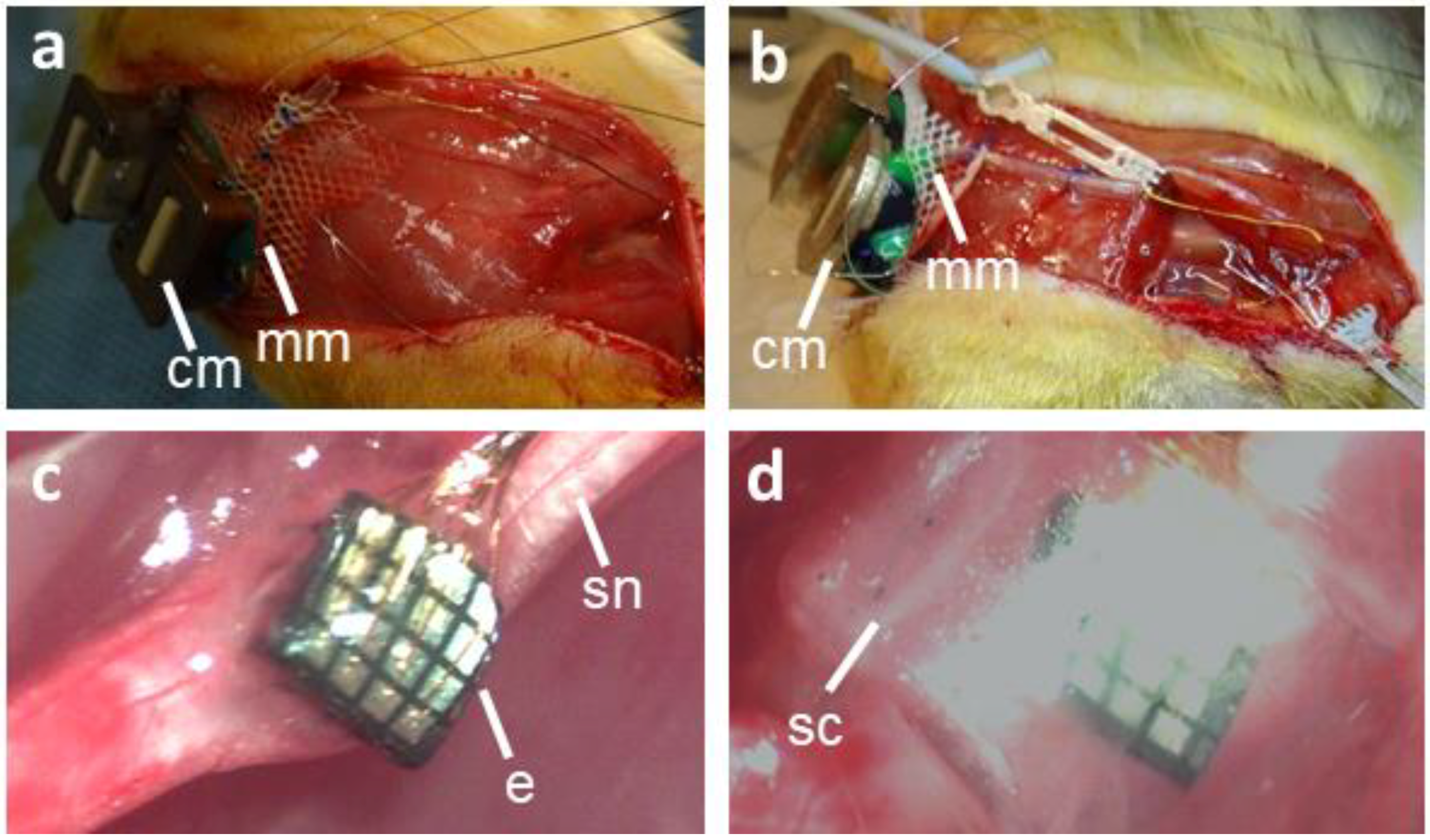
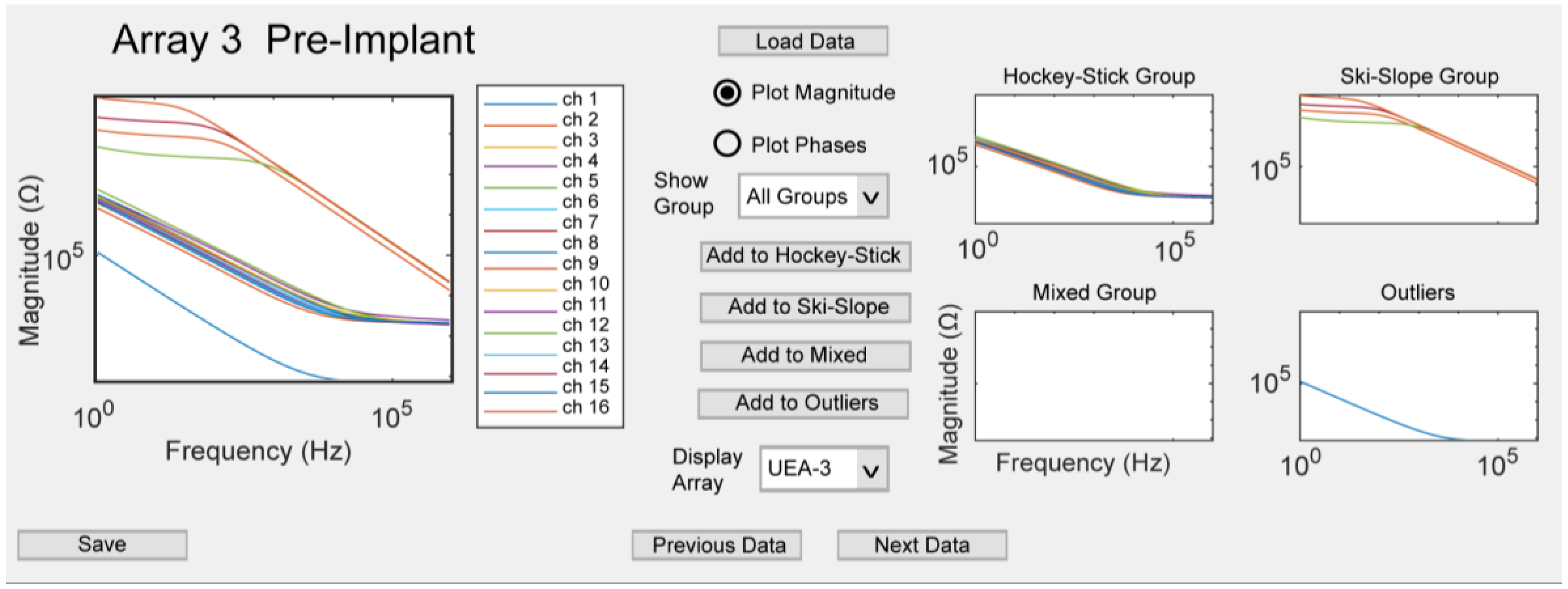

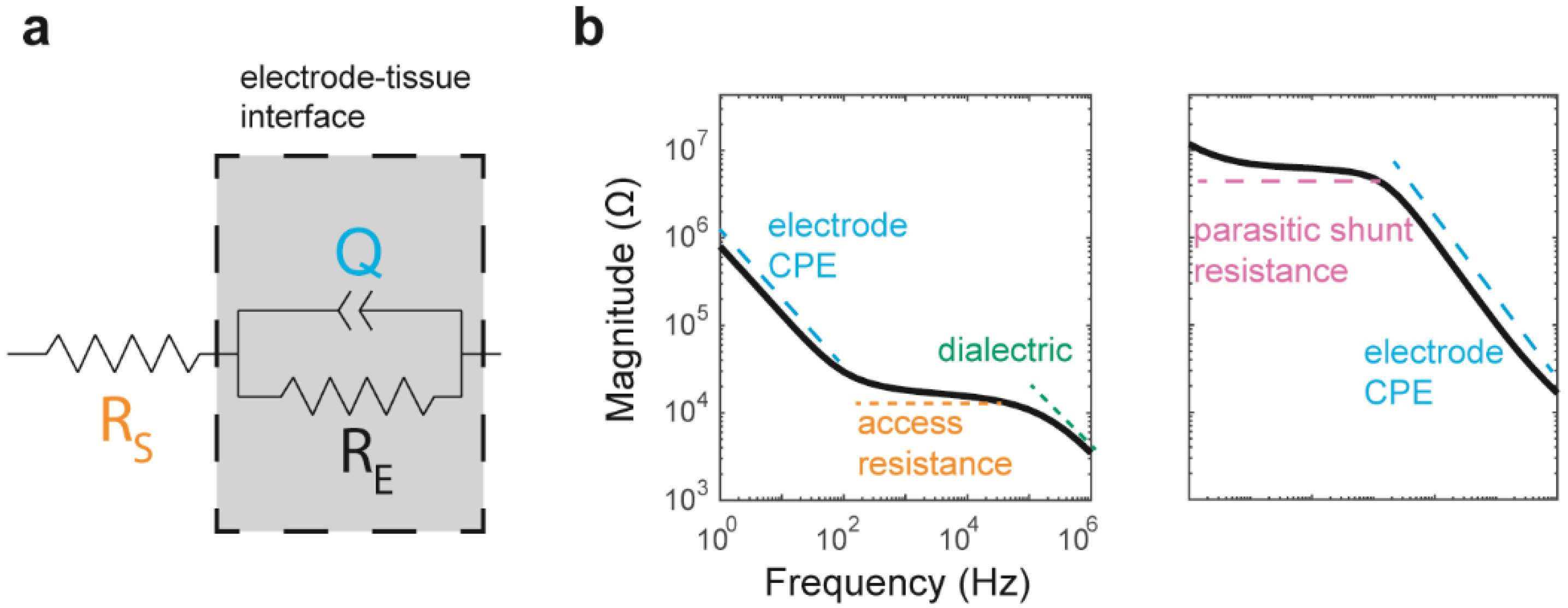
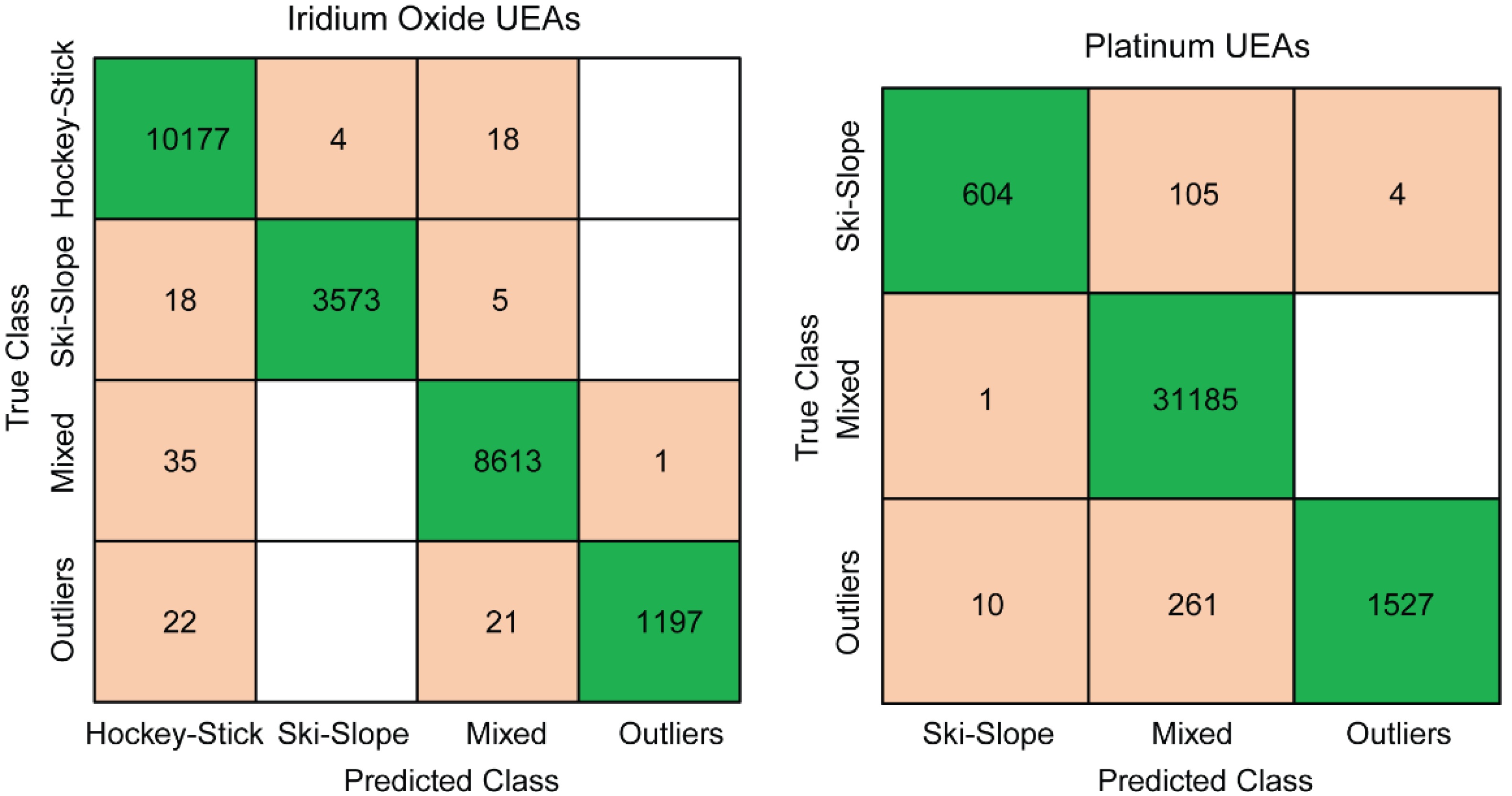
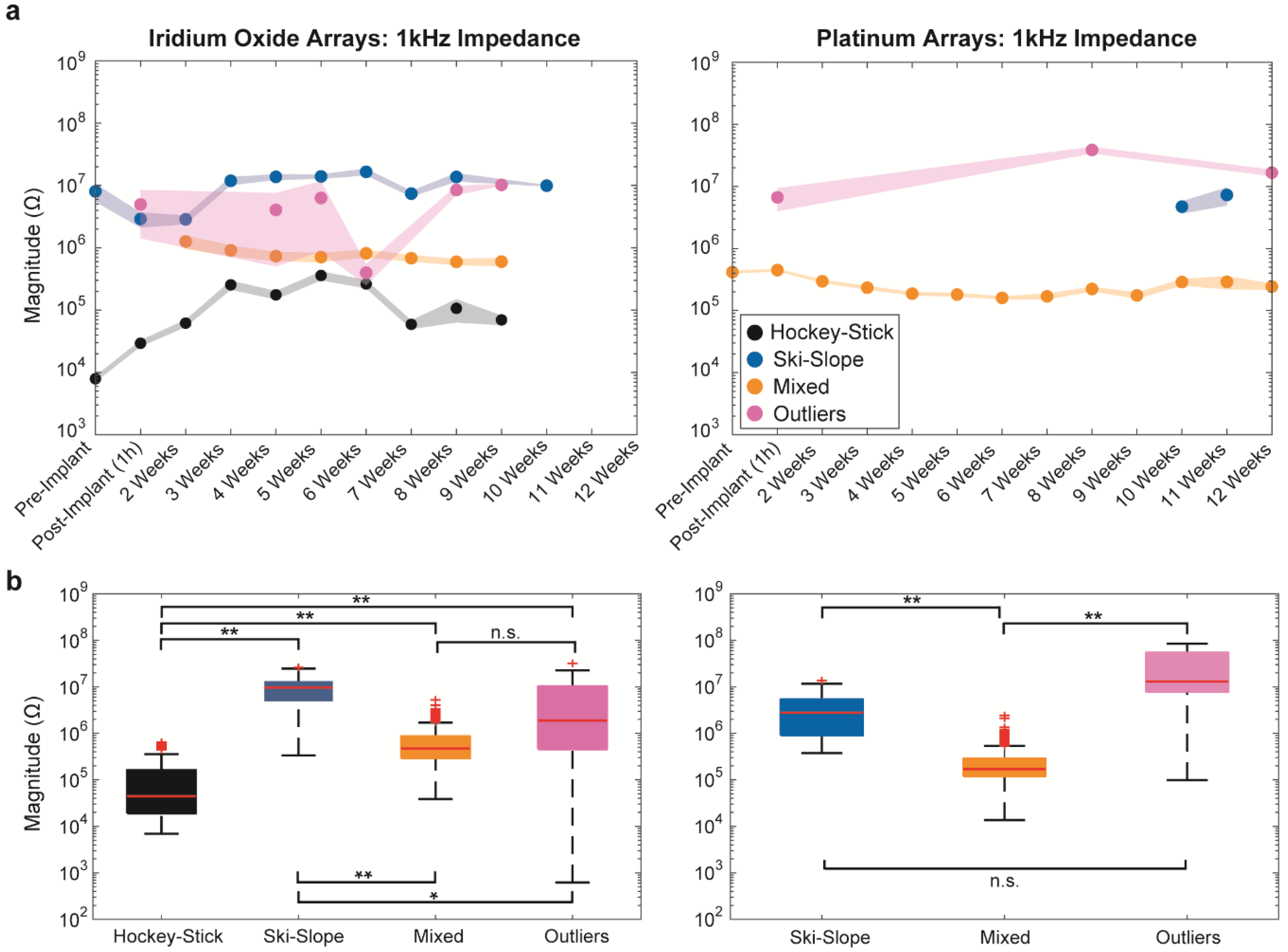

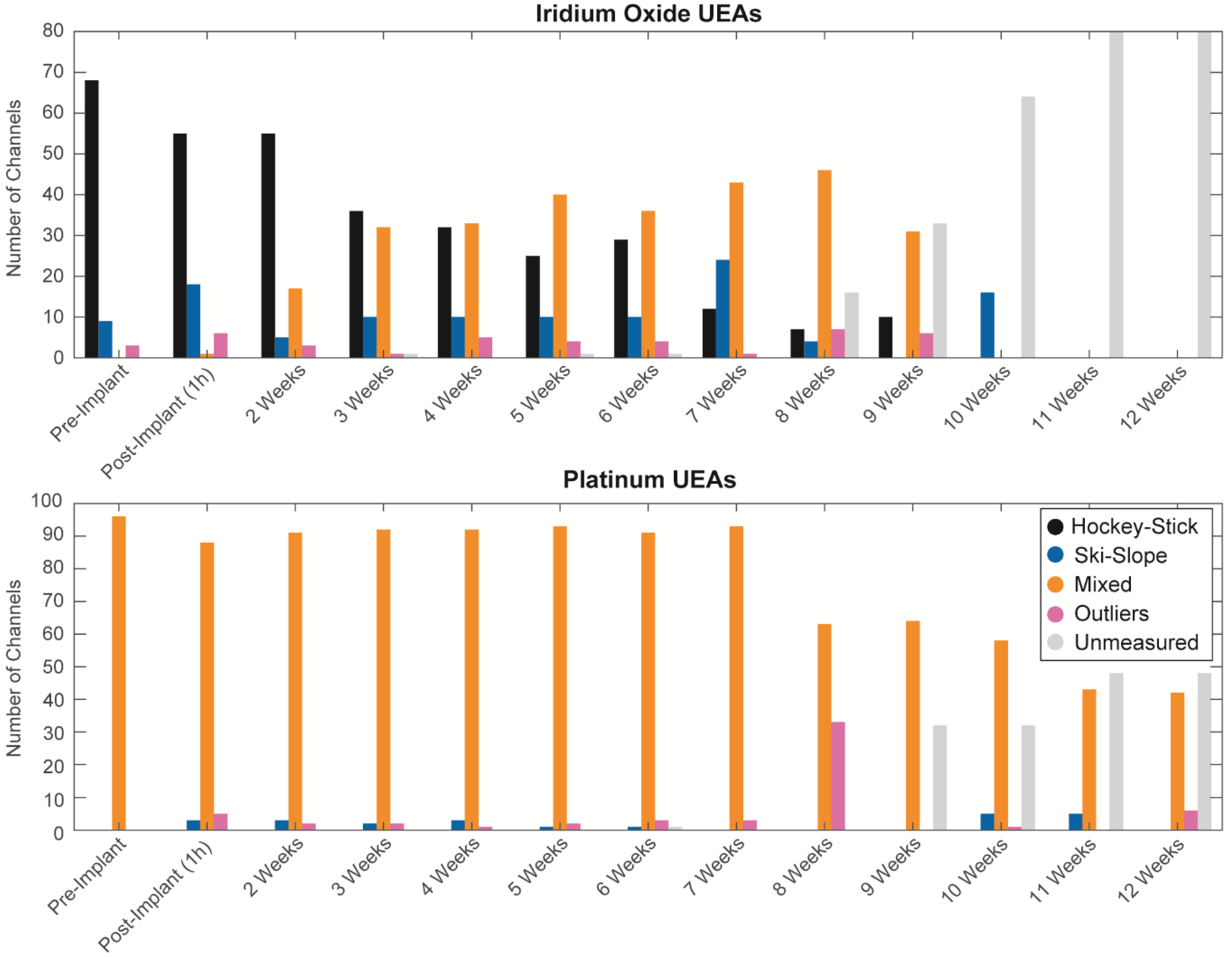
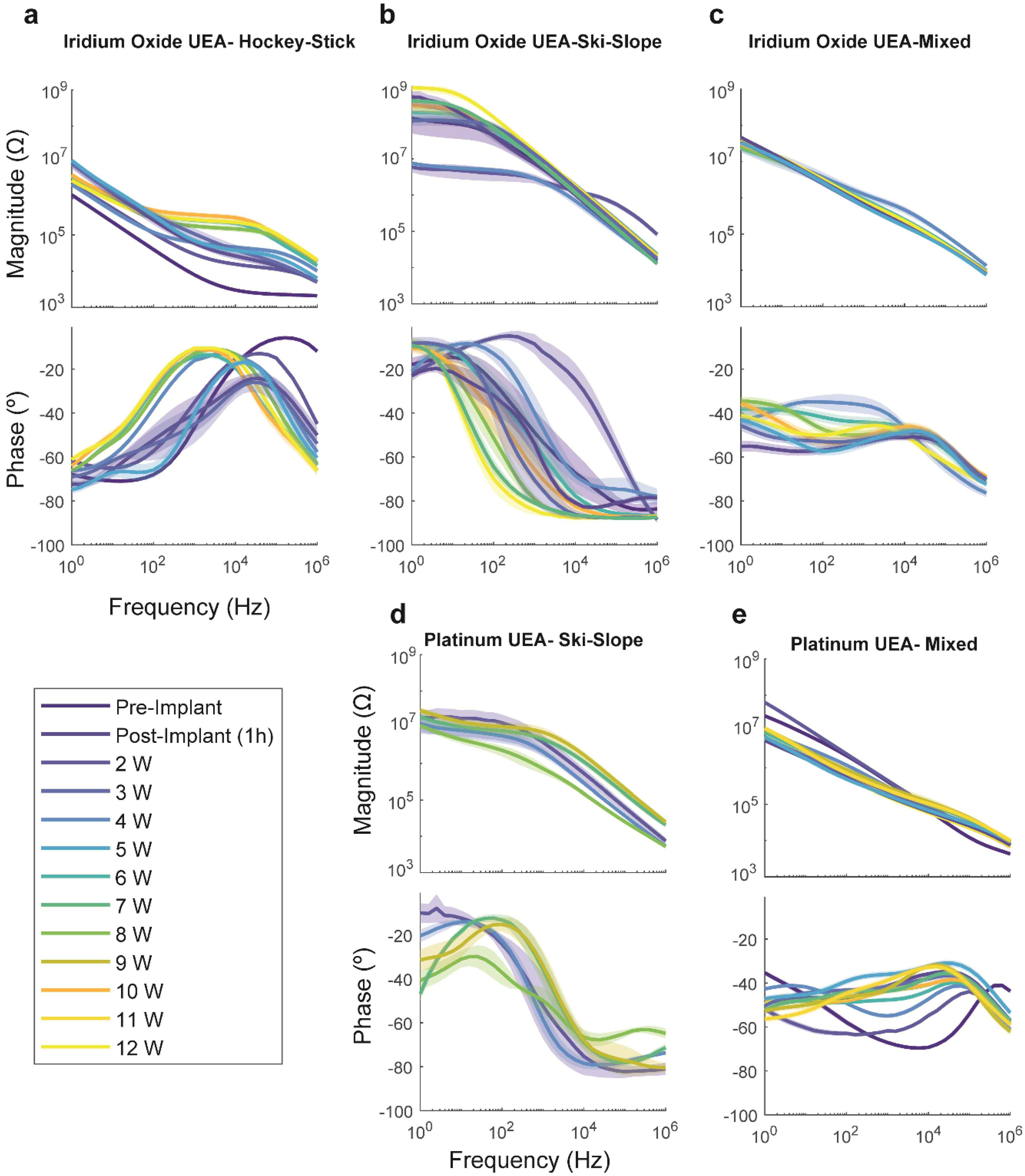
| Array Type | Group | Condition | Number Spectra | RE (1010 Ω) | Q (10−8 S s−n) | n | RS (kΩ) |
|---|---|---|---|---|---|---|---|
| Iridium Oxide | Hockey-stick | In vitro | 67 | 2.0 ± 0.4 | 22 ± 1 | 0.81 ± 0.01 | 2.17 ± 0.07 |
| In vivo | 205 | 6.2± 0.3 | 30 ± 2 | 0.64 ± 0.01 | 138 ± 12 | ||
| Ski-slope | In vitro | 9 | 2.1 ± 1.2 | 7.4 ± 3.2 | 0.68 ± 0.11 | 156 ± 90 | |
| In vivo | 99 | 1.0 ± 0.3 | 1.1 ± 0.3 | 0.85 ± 0.02 | 76 ± 28 | ||
| Mixed | In vitro | 4 | 4.5 ± 2.6 | 43 ± 34 | 0.75 ± 0.09 | 0.15 ± 0.12 | |
| In vivo | 299 | 3.0 ± 0.2 | 11 ± 2 | 0.61 ± 0.01 | 59 ± 7 | ||
| Outliers | In vitro | 0 | |||||
| In vivo | 17 | 6.8 ± 1.0 | 0.53± 0.35 | 0.89 ± 0.05 | 416 ± 245 | ||
| Platinum | Mixed | In vitro | 96 | 0.46 ± 0.18 | 0.72 ± 0.08 | 0.74 ± 0.01 | 7.3 ± 1.3 |
| In vivo | 854 | 5.0 ± 0.1 | 11 ± 1 | 0.55 ± 0.01 | 25 ± 2 | ||
| Outliers | In vitro | 0 | |||||
| In vivo | 42 | 1.1 ± 0.3 | 0.064 ± 0.062 | 0.96 ± 0.01 | 93 ± 20 |
© 2018 by the authors. Licensee MDPI, Basel, Switzerland. This article is an open access article distributed under the terms and conditions of the Creative Commons Attribution (CC BY) license (http://creativecommons.org/licenses/by/4.0/).
Share and Cite
Straka, M.M.; Shafer, B.; Vasudevan, S.; Welle, C.; Rieth, L. Characterizing Longitudinal Changes in the Impedance Spectra of In-Vivo Peripheral Nerve Electrodes. Micromachines 2018, 9, 587. https://doi.org/10.3390/mi9110587
Straka MM, Shafer B, Vasudevan S, Welle C, Rieth L. Characterizing Longitudinal Changes in the Impedance Spectra of In-Vivo Peripheral Nerve Electrodes. Micromachines. 2018; 9(11):587. https://doi.org/10.3390/mi9110587
Chicago/Turabian StyleStraka, Malgorzata M., Benjamin Shafer, Srikanth Vasudevan, Cristin Welle, and Loren Rieth. 2018. "Characterizing Longitudinal Changes in the Impedance Spectra of In-Vivo Peripheral Nerve Electrodes" Micromachines 9, no. 11: 587. https://doi.org/10.3390/mi9110587
APA StyleStraka, M. M., Shafer, B., Vasudevan, S., Welle, C., & Rieth, L. (2018). Characterizing Longitudinal Changes in the Impedance Spectra of In-Vivo Peripheral Nerve Electrodes. Micromachines, 9(11), 587. https://doi.org/10.3390/mi9110587





